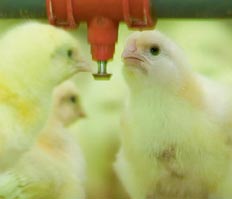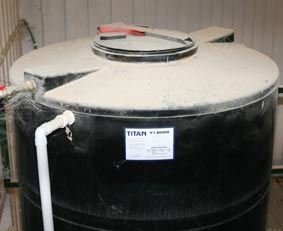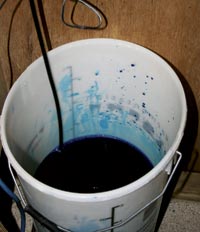New tips on water medicating broiler chicks

Pfizer’s Nigel Lodge offers new dosing tips based on his recent on-farm observations
It is essential to have medication available to the chicks when they first take a drink after arriving on broiler units, since they may have hatched early and have had a long journey to the farm. This is because bacteria that enter the bird’s navel can multiply dramatically within a few hours.
But as I outlined in my previous article (see p32, November 2007, Poultry World), even after bleeding each drinker line, it can still take at least seven hours for medication to reach all nipples in a shed. To get around this, bleed each line with a dye to establish the volume of water to be bled, as water line bleed points will vary in their distance from the medication point.
You only need to do this once per shed, unless changes are made to the pipe-work.
However since then, I have identified other potential shortcomings during audits of units using both header tanks and in-dosing systems. The first is taking account of the dramatic increase in water intake (see table), as chicks grow over the medication period (on average four days). Thus a decision has to be made on which of the following calculations to use.
The first option assumes the same volume of medication each day. This is easier as the dose does not have to be calculated daily. However, it will result in a diminishing daily dose per chick. For example, with a shed of 16,000 birds given 150g of Linco-Spectin per day (equates to 100g of active constituents), the daily dose drops from 148 to 70mg of actives per kg bodyweight over four days as the chicks grow rapidly.
Alternatively, you opt for an increasing volume of medication each day in order to keep the dose per chick the same. So if the target dose is 100mg of actives per kg bodyweight, then the amount of medication given has to be increased daily (in this example, from 100 to 216g per day). A chart in each shed, based on the number of chicks, will act as an easy reference.
Your vet will be able to advise you on which option to opt for, as this will depend on your farm situation. Once you have selected which calculation, you will then need to consider the method of administrating the medication.

It is necessary to turn off the water supply to the header tank to ensure there is not an ongoing dilution of the medicated water
Header tanks
For sheds with header tanks, the length of medication period (the time to empty the header tank) should be established by day to ensure chicks are medicated for as long a period as possible each day. Pulse dosing (medicating over a fixed period each day, such as 12 hours) is possible, but careful calculations are required. In addition if a very concentrated solution is given for a short period, palatability may become an issue.
The ideal is to have the chicks receiving medication for as close to 24 hours per day as possible. For example, 30,000 chicks weighing 42g (1260 kg total bodyweight) are delivered to a shed with a 500-litre header tank and are to be medicated at 100mg of actives/kg bodyweight (150 mg of Linco-Spectin/kg bodyweight).
Chicks will drink a total of 780 litres over the first 24 hours in the shed and the dose for the first day is 1260 x 150mg which comes to 189g of medication. Therefore, 189g should be added to 780 litres (or 121g into the 500-litre header tank).
This means it is necessary to turn off the water supply to the header tank to ensure there is not an ongoing dilution of the medicated water. Once the tank is empty, the water should be turned on again until the tank holds 280 litres and the remaining 68g of medication added. Following this regime gives 24 hours’ medication. If the entire daily amount was added to 500 litres, the medication pulse would be 15.4 hours, which is also satisfactory.
On units where the header tank is much larger and the chicks do not fully empty it daily, it may have to be part-filled. Therefore, measure and mark the level accurately.
Hygiene in header tanks is important – there should be no sludge at the bottom of the tank and a lid should be in place to prevent this. On top of this, mixing the antibiotic in the header tank is important to ensure even dispersion before the medicated water leaves the tank.
In-line medicators

Ensure the intake pipe is always beneath the surface
For sheds with in-line medicators, the concentrated solutions are prepared and introduced into the shed drinker line at a set dilution rate – usually 1 or 2%. By calculating the volume of water in the concentrate solution, a 24-hour medication period (the time to empty the concentrate container) can be established.
Again using the example given earlier, 1% of the 780 litres which the birds will drink over the first 24 hours is 7.8 litres. This is the volume that should be in the concentrate container. Thus the dose for the first day is 1260 x 150mg which comes to 189g of medication.
Doses for the next three days are 260, 327 and 404g, respectively, and the volume of water in the reservoir should be 8.1, 9.3, and 10.5 litres, respectively. When measuring the correct weight of medication. I recommend using weighing scales.
A cover should be used to prevent contamination entering the open top of the container holding the concentrate solution and only stainless steel and plastic should be allowed to come into contact with the stock solution.
There should be a foolproof method of draining the container holding the concentrate solution, so that minimal solution is left over after each 24-hour period. Ensure the intake pipe is always beneath the surface.
Late arrival
Allowance must be made for the late arrival of chicks, which sometimes occurs, to ensure that 24-hour calculations on water intake apply. If medication is administered every 24 hours after arrival, there will be no problem. However, if medication is administered first thing each day, then a pro-rata reduction should be made on day 0 (day of arrival).
Nigel Lodge is the technical manager at Pfizer Animal Health.
| Water intake | ||
|---|---|---|
| Day | Chick weight (g) | Estimated water intake (ml) |
| 0 | 42 | 26 |
| 1 | 57 | 27 |
| 2 | 72 | 31 |
| 3 | 89 | 35 |
